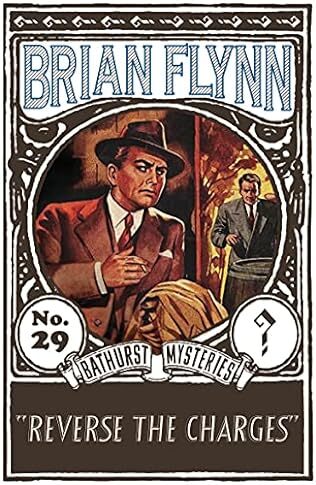Reverse The Charges

A review of Reverse The Charges by Brian Flynn – 230916
The ever-inventive Brian Flynn brightened up the war years with the highly entertaining and yet slightly bonkers Reverse The Charges, the twenty-ninth in his long running Anthony Bathurst series, which was originally published in 1943 and rescued from obscurity by Dean Street Press. There are corpses galore, four murders, an attempted murder with the assassin doing serious damage to a mannequin with an axe, and the inevitable suicide of the culprit, unmasked in Poirot-style as all the interested parties are gathered together in a room to hear the great sleuth reveal his understanding of what happened.
Set in Mallett in Glebeshire, the life of the town is rocked when a farmer by the name of William Norman is killed while driving his car from an evening at the White Lion, having had six burning cinder pellets put down the back of his neck by his passenger. A second murder soon follows, that of the baker, Henry King, who ingested a poisoned fish while lunching at the White Lion. The next victim is George Clarence, a ne’er do well, whose body was found feet up in a barrel in the courtyard of the White Lion, the water in the barrel having been tainted with port. The fourth victim is an eleven-year-old boy, Richard Yorke, who was smothered to death by a cushion and whose body was found on a settee in the White Lion.
You do not have to be a keen student of royal history to realise that the Chief Constable, who goes by the name of Sir Charles Stuart, might be in serious danger and likely to be attacked with an axe. However, it takes Bathurst a long time to make the connections, his excuse, not unreasonably being that he could only deal with the facts as they presented themselves to him. He was called in after the first murder and takes several to occur before a link becomes apparent.
Before that, there are some significant distractions. Was the culprit a homicidal maniac with no logic to their actions or was there something significant in the curious fact that each of the victims were suffering from advanced terminal illnesses? Could the murders be seen as a form of kindness, a form of euthanasia to relieve them of their sufferings? Was the link to the White Lion in each of the four murders of any significance? And why was Clarence in the process of selling a stamp collection, which he had stolen, and why did it end up in the possession of Mallett’s acknowledged philatelist, one of King’s fellow diners at the White Lion?
There is much for Bathurst to think about but in conjunction with his old sparring partner, Inspector MacMorran of the Yard, and Venables of the local police who receives a blow to his head for his troubles, they ponder all the points of the case, and resolution seems to come out of the blue when a dying man by the name of Jordan makes a full confession.
However, Bathurst is not satisfied and ponders the case some more. The causal link and the whodunit are not too difficult to spot, but the motive seems to come a little out of the blue and you cannot help thinking that the plans of the murderer are a little too involved to settle what is effectively an old score, a love spurned.
Each of the four murders require a high degree of planning, selecting the right victims with the right names and matching a means of despatch that matches their monikers and then being able to commit the murders undetected. The first murder, using burning coals which not only have to be kept warm and hidden from the intended victim, but also pushed down his back while he is driving. The second relies on the plate of food being left unattended at the serving hatch for a vital few seconds. As the murders are merely a smokescreen to throw off suspicion ahead of the main event, the murder of Stuart, it all seems too much effort.
However, it does not do to spend too much time wondering about the logic of the plot. This is a Flynn tour de force in which his narrative power, imagination, and wit carries all before it. Great fun.
Oh, and I thought I was well up on my cricket history but the reference to Lionel Palairet got through my guard and broke my stumps.



